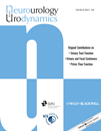Abstract
Aims
Minimum important difference (MID) estimates the minimum degree of change in an instrument's score that correlates with subjective sense of improvement. The aim of this study was to estimate the MID for the Urogenital Distress Inventory (UDI), Incontinence Impact Questionnaire (IIQ) and Overactive Bladder Questionnaire (OAB-q) using anchor and distribution-based approaches in patients with urge-predominant incontinence and whether MID changes over time.
Methods
This was a sub-analysis of a multi-center trial of 307 women with pure urge (11) or urge-predominant (296) incontinence who completed condition-specific instruments 10 weeks and 8 months after randomization to anticholinergic medication with or without behavioral therapy. We applied anchor-based methods only when the Kendall's rank correlations between the anchors (Global Perception of Improvement (GPI), Patient Satisfaction Questionnaire (PSQ), and incontinence episodes) and the incontinence instruments (UDI, UDI irritative subscale, IIQ, and OAB-q subscales) were ≥0.3. We applied three distribution-based methods to all instruments: effect sizes of ±0.2 SD (small) and ±0.5 SD (medium), and standard error of measurement of ±1. Analyses were performed at both time points.
Results
Anchor-based MIDs for the UDI ranged from −35 to −45 and −15 to −25 for the irritative subscale distribution-based methods MIDs for UDI and IIQ ranged between −10 to −25 and −19 to −49, respectively, reflective of a reduction in bother and symptom severity (SS). OAB-q subscale MIDs ranged from +5 to +12, denoting improved quality of life (HRQL) and −13 to −25, consistent with a reduction in SS.
Conclusions
The MID in women with urge-predominant UI for the UDI and UDI irritative are −35 and −15. Our findings are consistent with previously reported MIDs for the OAB-q subscales. Distribution-based method MIDs are lower values than anchor-based values. The MID did not typically change over the time. Neurourol. Urodynam. 30:1319–1324, 2011. © 2011 Wiley-Liss, Inc.




